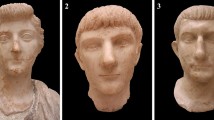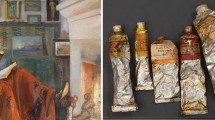Abstract
Violet–purple residues collected from a Gallo–Roman burial dated back to the second half of the third century A.D. and excavated at Naintré (France) were chemically investigated by multi-analytical methodology involving the use of Raman spectroscopy, direct exposure-mass spectrometry (DE-MS) and high-performance liquid chromatography (HPLC–UV–visible). Little is known about funeral treatment and rituals during Roman times. Retrieving valuable information on these by chemical analysis of organic residues was thus a key aspect of this work. Analyses demonstrated the presence of the very precious purple colorant obtained from shellfish glands commonly known as Tyrian or royal purple and its exceptional preservation. Chemical investigation and archaeological evidence have shown that purple was widely spread after the deposition of the body for burial. These results are the earliest chemical evidence of purple colorant used during funeral rituals (not as textile dye) and enabled us to highlight new aspects of funeral practices in Roman times.






Similar content being viewed by others
References
Farago-Szekeres B (1998) Découverte exceptionnelle de deux tombes gallo-romaines à Naintré (Vienne). Ministère de la culture (France). http://www.culture.gouv.fr/culture/arcnat/naintre/naintre1.htm. 2008
Harrington SPM (1998) Gallo-Roman sarcophagi find. Archaeology 51(4)
Toynbee JM (1971) Funerary rites and the cult of the dead. In: Press TJHU (ed) Death and burial in the Roman world. Baltimore, p 336
Farago-Szekeres B (2001) Rapport de fouille “Trois sépultures privilégiées du Bas Empire”. Service Regional de l’Archéologie Poitou-Charantes, Anché
Cooksey CJ Tyrian purple: history, chemistry and sources. http://www.chriscooksey.demon.co.uk/tyrian/. Accessed 17/03/2011 2011
Cooksey CJ (2001) Tyrian purple: 6,6′-dibromoindigo and related compounds. Molecules 6:736–769
Clark RJH, Cooksey CJ, Daniels MAM, Withnall R (1993) Indigo, woad, and Tyrian purple: important vat dyes from antiquity to the present. Endeavour 14(4):191–199
Clark RJH, Cooksey CJ, Daniels MAM, Withnall R (1996) Indigo - red, white and blue. Educ Chem 33(1):16–19
Bruni S, Guglielmi V, Pozzi F (2010) Surface-enhanced Raman spectroscopy (SERS) on silver colloids for the identification of ancient textile dyes: Tyrian purple and madder. J Raman Spec 41(2):175–180. doi:10.1002/jrs.2456
Ferreira ESB, Hulme AN, McNab H, Quye A (2004) The natural constituents of historical textile dyes. Chem Soc Rev 33(6):329–336
Degano I, Ribechini E, Modugno F, Colombini MP (2009) Analytical methods for the characterization of organic dyes in artworks and in historical textiles. Appl Spectrosc Rev 44(5):363–410
Rosenberg E (2008) Characterisation of historical organic dyestuffs by liquid chromatography–mass spectrometry. Anal Bioanal Chem 391(1):33–57
Lech K, Połeć-Pawlak K, Jarosz M (2009) Chapter 13. Characterization of organic natural dyes by electrospray mass spectrometry coupled with HPLC and/or capillary electrophoresis. In: Colombini MPFM (ed) Organic mass spectrometry in art and archeology. Wiley, New York, p 365. doi:10.1002/9780470741917.ch13
Darlene F, McCrone A, Westmont I, Elmhurst C, Elmhurst I (2003) Spectral comparison of commercial and synthesized Tyrian purple. Modern Microscopy Journal
Clark RJH, Cooksey CJ (1999) Monobromoindigos: a new general synthesis, the characterization of all four isomers and an investigation into the purple colour of 6,6′-dibromoindigo. New J Chem 23(3):323–328
Karapanagiotis T, Villar SE, Bowen RD, Edwards HGM (2004) Raman spectroscopic and structural studies of indigo and its four 6,6′-dihalogeno analogues. Analyst 129(7):613–618
Tatasch E, Schrader B (1995) Near-infrared Fourier transform Raman spectroscopy of indigoids. J Raman Spectrosc 26(6):467–473. doi:10.1002/jrs.1250260611
Edwards HGM, Newton EM, Wynn-Williams DD, Lewis-Smith RI (2003) Non-destructive analysis of pigments and other organic compounds in lichens using Fourier-transform Raman spectroscopy: a study of Antarctic epilithic lichens. Spectrochim Acta A Mol Biomol Spectrosc 59(10):2301–2309. doi:10.1016/s1386-1425(03)00073-8
McGovern PE, Michel RH (1990) Royal purple dye: its identification by complementary physicochemical techniques. MASCA Res Papers Sci Archaeol 7:69–76
James MA, Reifarth N, Mukherjee AJ, Crump MP, Gates PJ, Sandor P, Robertson F, Pfalzner P, Evershed RP (2009) High prestige Royal Purple dyed textiles from the Bronze Age royal tomb at Qatna, Syria. Antiquity 83(322):1109–1118
Tanoue Y, Sakata K, Hashimoto M, Hamada M, Kai N, Nagai T (2004) A facile synthesis of 6,6′- and 5,5′ dihalogenoindigos. Dye Pigment 62(2):101–105. doi:10.1016/S0143-7208(03)00150-5
Hoffman RC, Zilber RC, Hoffman RE (2010) NMR spectroscopic study of the Murex trunculus dyeing process. Magn Reson Chem 48(11):892–895. doi:10.1002/mrc.2685
Andreotti A, Bonaduce I, Colombini MP, Ribechini E (2004) Characterization of natural indigo and shellfish purple by mass spectrometric techniques. Rapid Comm Mass Spec 18:1213–1220
McGovern PE, Michel RH (1990) Royal purple dye: the chemical reconstruction of the ancient mediterranean industry. Accounts Chem Res 23(5):152–158
Karmous T, Ayed N (2001) Orchil Lichens of Tunisia: Chromatographic Identification and Dyeing System Dyes in history and archaeology 16/17:119–128
Wouters J (1985) High performance liquid chromatography of anthraquinones: analysis of plant and insect extracts and dyed textiles. Stud Conserv 30(3):119–128
Karapanagiotis I, de Villemereuil V, Magiatis P, Polychronopoulos P, Vougogiannopoulou K, Skaltsounis A-L (2006) Identification of the coloring constituents of four natural indigoid dyes. J Liq Chromatogr Relat Technol 29(10):1491–1502
Karapanagiotis I (2006) Identification of indigoid natural dyestuffs used in art objects by HPLC coupled to APCI-MS. Am Lab 38(3):36–40
Koren ZC (2007) Archaeo-chemical analysis of royal purple on a Darius I stone. Microchimica Acta 162:381–392
Pawlak K, Puchalska M, Miszczak A, Rosłoniec E, Jarosz M (2006) Blue natural organic dyestuffs—from textile dyeing to mural painting. Separation and characterization of coloring matters present in elderberry, logwood and indigo. J Mass Spectrom 41(5):613–622
Puchalska M, Połeć-Pawlak K, Zadrozna I, Hryszko H, Jarosz M (2004) Identification of indigoid dyes in natural organic pigments used in historical art objects by high-performance liquid chromatography coupled to electrospray ionization mass spectrometry. J Mass Spectrom 39(12):1441–1449
Orska-Gawrys J, Surowiec I, Kehl J, Rejniak H, Urbaniak-Walczak K, Trojanowicz M (2003) Identification of natural dyes in archeological Coptic textiles by liquid chromatography with diode array detection. J Chromatogr A 989(2):239–248. doi:10.1016/S0021-9673(03)00083-9
Surowiec I, Quye A, Trojanowicz M (2006) Liquid chromatography determination of natural dyes in extracts from historical Scottish textiles excavated from peat bogs. J Chromatogr A 1112(1–2):209–217. doi:10.1016/j.chroma.2005.11.019
Halpine SM (1996) An improved dye and lake pigment analysis method for high-performance liquid chromatography and diode-array detector. Stud Conserv 41(2):76–94
Wouters J (1991) A new method for the analysis of blue and purple dyes in textiles. Paper presented at the 10th Annual Meeting Dyes in History and Archaeology, National Gallery London
Wouters J, Noemi R-C (1992) Dye analysis of pre-Columbian Peruvian textiles with high-performance liquid chromatography and diode-array detection. J Am Inst Conserv 31(2):237–255
Koren ZC (1994) HPLC analysis of the natural scale insect, madder and indigoid dyes. J Soc Dye Colour 110(9):273–277
Koren ZC An efficient HPLC analysis scheme for plant and animal red, blue and purple dyes. In: 13th Annual Meeting Dyes in History and Archaeology, Edinburgh, 1994. pp 27–37
Nowik W, Desrosiers S, Surowiec I, Trojanowicz M (2005) The analysis of dyestuffs from first- to second-century textile artefacts found in the Martres-de-Veyre (France) excavations. Archaeometry 47(4):835–848
Nowik W (1996) Application de la chromatographie en phase liquide à l'identification des colorants naturels des textiles anciens: L'étude des matériaux anciens. Analusis 24(7):37–40
Trojanowicz M, Orska-Gawrys J, Surowiec I, Szostek B, Urbaniak-Walczak K, Kehl J, Wróbel M (2004) Chromatographic investigation of dyes extracted from Coptic textiles from the National Museum in Warsaw. Stud Conserv 49:115–130
Nowik W, Marcinowska R, Kusyk K, Cardon D, Trojanowicz M (2011) High performance liquid chromatography of slightly soluble brominated indigoids from Tyrian purple. J Chromatogr A 1218(9):1244–1252. doi:10.1016/j.chroma.2011.01.004
Wehling B, Vandenabeele P, Moens L, Klockenkämper R, von Bohlen A, Van Hooydonk G, de Reu M (1999) Investigation of pigments in medieval manuscripts by micro Raman spectroscopy and total reflection X-ray fluorescence spectrometry. Microchimica Acta 130(4):253–260. doi:10.1007/BF01242913
Sotiropoulou S, Karapanagiotis I (2006) Conchylian purple investigations in prehistoric wall paintings of the Aegean area. In: Meijer L, Guyard N, Skaltsounis L, Eisenbrand G (eds) Indirubin, the red shade of indigo. Life in Progress, Roscoff, pp 71–78
Acknowledgements
The Italian National Project PRIN07 is acknowledged for funding part of this research.
Author information
Authors and Affiliations
Corresponding author
Additional information
Published in the special issue Analytical Chemistry to Illuminate the Past with guest editor Maria Perla Colombini.
Rights and permissions
About this article
Cite this article
Devièse, T., Ribechini, E., Baraldi, P. et al. First chemical evidence of royal purple as a material used for funeral treatment discovered in a Gallo–Roman burial (Naintré, France, third century AD). Anal Bioanal Chem 401, 1739–1748 (2011). https://doi.org/10.1007/s00216-011-5217-7
Received:
Revised:
Accepted:
Published:
Issue Date:
DOI: https://doi.org/10.1007/s00216-011-5217-7




